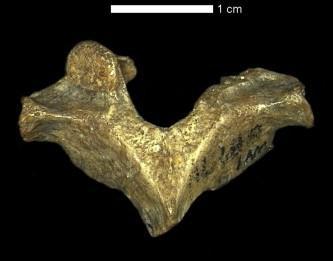
Lucy (more commonly called AL 288-1 by the public) is one of the most important skeletons of our ancestors ever found. This is because it's a very complete fossil of Australopithecus; which were the more ape-like species that preceded us. However this very complete skeleton is actually a bit less intact than we thought. A recent re-analysis of Lucy's vertebrae has revealed that it doesn't actually belong to her.
Or at least, one of her backbones doesn't. There are 9 bones associated with Lucy's vertebrae; one of which is rather odd. It's a lot smaller and more damaged than the others. This has led to disagreement amongst scientists about where abouts it fits in with the rest of Lucy's vertebrae. It's supposed to go somewhere in the upper part of her back, but nobody can quite figure out where. And why is it more weathered than the rest of her bones? Did Lucy leave it exposed for a while before she died?
However a new study reveals it doesn't actually belong to Lucy after all. The bone (sometimes called "-1am"; aka my bedtime) is way too small to be hers. It's also missing some of the key components that identify a human backbone. Why did this remain undiscovered for so long? Well, the missing components are hard to measure, unless you know what you're trying to compare it to. In this case, they tried comparing it to baboons and found it matched up quite nicely.
All of which raises the question: so what? Lucy's vertebrae had 9 bones, now it has 8. If it was complete, it would have ~33. What can a portion of a backbone tell us?
Well, the backbone is important because - unlike the popular saying would suggest - it's actually quite flexible. It will adapt and change depending on your lifestyle. If you walk upright (as humans sometimes do) it will develop a series of curves that keep the center of gravity...well, center. This is known as lumbar lordosis.
Crucially, lumbar lordosis isn't evolved. It's something that develops over an individual's life depending on how they move. If you make a monkey walk on two legs (as some street performers do) it will get lumbar lordosis. Lucy has some characteristics well suited for climbing and some well suited for walking upright ( and, according to a few people, some well suited for knuckle walking). Which did she spend most of her time doing? Well, if Lucy's vertebrae contained evidence of lumbar lordosis then that would be clear evidence that walking upright was her preferred way of getting around.
Alas the 8 (or even 9) bones of Lucy's vertebrae aren't enough to identify lumbar lordosis. Fortunatley, it's not as though Lucy is the only Australopithecus fossil we've found. Sure she might be the most famous, but we've found others with nice segments of backbone. And in every fossil we've found that had enough spine to study we've found evidence of lumbar lordosis.
So Lucy has lost a bone, but she's gained a lot more credibility as a bipedal ape.
References
Been, E., Gómez‐Olivencia, A., & Kramer, P. A. (2012). Lumbar lordosis of extinct hominins. American journal of physical anthropology, 147(1), 64-77.
Meyer, M. R., Williams, S. A., Smith, M. P., & Sawyer, G. J. (2015). Lucy's back: Reassessment of fossils associated with the AL 288-1 vertebral column. Journal of human evolution.
Nakatsukasa, M., Hayama, S., & Preuschoft, H. (1995). Postcranial skeleton of a macaque trained for bipedal standing and walking and implications for functional adaptation. Folia Primatologica, 64(1-2), 1-29.

